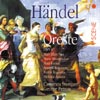Handel Oreste
Handel recycled by Handel kept the customers satisfied – and it still does
View record and artist detailsRecord and Artist Details
Composer or Director: George Frideric Handel
Genre:
Opera
Label: Scene
Magazine Review Date: 12/2004
Media Format: CD or Download
Media Runtime: 147
Mastering:
Stereo
DDD
Catalogue Number: MDG609 1273-2

Tracks:
| Composition | Artist Credit |
|---|---|
| Oreste |
George Frideric Handel, Composer
Antonis Koroneos, Pilade, Tenor George Frideric Handel, Composer George Petrou, Conductor Maria Mitsopoulou, Ermione, Soprano Mary-Ellen Nesi, Oreste, Mezzo soprano Mata Katsuli, Ifigenia, Soprano Nicholas Spanos, Filotete, Countertenor Petros Magoulas, Toante, Bass Stuttgart Camerata |
Author: David Vickers
During the 1730s Handel padded out his London opera seasons with pasticci, assembled using arias by his favourite contemporaries (notably Vinci). There are three exceptions that consist entirely of Handel’s own music: Oreste, Alessandro Severo and Jupiter in Argos. In these forgotten operas, Handel cannily adapted a mixture of old and recent arias to a new libretto, and composed a few new pieces where necessary. Scholars have considered them unworthy of inclusion in the accepted canon, but this seems rather snobbish if one remembers that Handel used the same formula to assemble Rinaldo (1711) for his London début.
While Oreste (1734) lacks the spectacular effects and entertaining magic that helps one overlook the weak plot of Rinaldo, the later pasticcio is a stronger drama. The plot is similar to Gluck’s Iphigénie en Tauride: the arrival of the bedraggled Oreste at Tauris is complicated by the tyrannical King Toante’s death sentence on all strangers. Oreste is rescued and protected by his long-lost sister Ifigenia. In the meantime his wife Ermione arrives on the island searching for her husband, but instead attracts Toante’s lustful attention.
Most of the recycled arias are attractively efficient in their new garb. Agrippina’s ‘Pensieri’ is converted into an intense opening scene in which Oreste is plagued by furies. It is fascinating to discover that some arias are more powerful here than in their original context (‘Dite pace’ works much better closing Act I of Oreste than it did in Sosarme), although it is fair to concede that others do not (Oreste’s friend Pilade making an emotional farewell so early in Act I hardly compares with the dying Bajazet’s consolation of his daughter in the suicide scene from Tamerlano).
This recording is a treasure trove for the Handelian trainspotter, although it is poor that the booklet does not contain a clear list of the music’s sources. The Greek singers on this première recording are secure, but the distant acoustic does not help the woolly delivery of text by the bass and tenor soloists. Camerata Stuttgart’s playing is generally crisp, theatrical, and tasteful, although the modern instruments occasionally sound soggy. George Petrou’s direction is ideal, and this efficient team performance gives Oreste an admirable chance to be taken more seriously.
While Oreste (1734) lacks the spectacular effects and entertaining magic that helps one overlook the weak plot of Rinaldo, the later pasticcio is a stronger drama. The plot is similar to Gluck’s Iphigénie en Tauride: the arrival of the bedraggled Oreste at Tauris is complicated by the tyrannical King Toante’s death sentence on all strangers. Oreste is rescued and protected by his long-lost sister Ifigenia. In the meantime his wife Ermione arrives on the island searching for her husband, but instead attracts Toante’s lustful attention.
Most of the recycled arias are attractively efficient in their new garb. Agrippina’s ‘Pensieri’ is converted into an intense opening scene in which Oreste is plagued by furies. It is fascinating to discover that some arias are more powerful here than in their original context (‘Dite pace’ works much better closing Act I of Oreste than it did in Sosarme), although it is fair to concede that others do not (Oreste’s friend Pilade making an emotional farewell so early in Act I hardly compares with the dying Bajazet’s consolation of his daughter in the suicide scene from Tamerlano).
This recording is a treasure trove for the Handelian trainspotter, although it is poor that the booklet does not contain a clear list of the music’s sources. The Greek singers on this première recording are secure, but the distant acoustic does not help the woolly delivery of text by the bass and tenor soloists. Camerata Stuttgart’s playing is generally crisp, theatrical, and tasteful, although the modern instruments occasionally sound soggy. George Petrou’s direction is ideal, and this efficient team performance gives Oreste an admirable chance to be taken more seriously.
Discover the world's largest classical music catalogue with Presto Music.

Gramophone Digital Club
- Digital Edition
- Digital Archive
- Reviews Database
- Full website access
From £8.75 / month
Subscribe
Gramophone Full Club
- Print Edition
- Digital Edition
- Digital Archive
- Reviews Database
- Full website access
From £11.00 / month
Subscribe
If you are a library, university or other organisation that would be interested in an institutional subscription to Gramophone please click here for further information.




